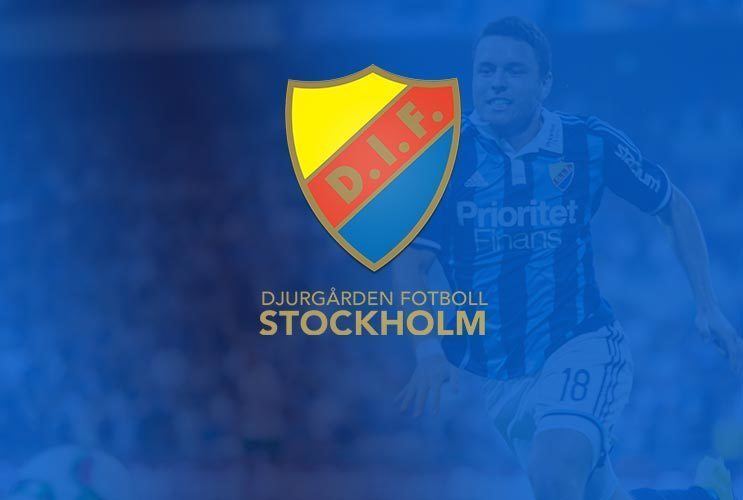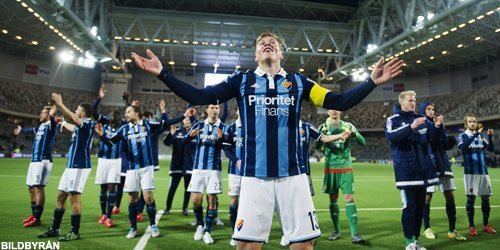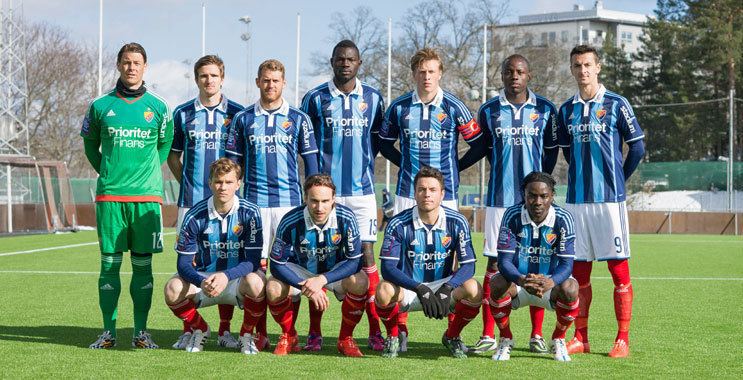Short name DIF Ground Capacity 30,000 | Chairman Lars-Erik Sjöberg Manager Özcan Melkemichel Founder Teodor Andersson | |
 | ||
Full name Djurgårdens Idrottsförening CEO Henrik Berggren (9 Dec 2013–) Profiles | ||
Djurgårdens IF Fotbollsförening, commonly known as Djurgårdens IF, Stockholms Golbögar Djurgården Fotboll, Djurgården [²jʉːʳˌɡoːɖɛn], informally Djurgår'n [ˈjʉːʳɡɔɳ] and (especially locally) Dif or DIF, is the association football department of Djurgårdens IF and is based at Tele2 Arena in the Johanneshov district of Stockholm.
Contents
- Foundation
- First era
- Second era
- Middle years
- Third era
- Present days
- Supporters and rivalries
- Notable Djurgrden supporters
- Rivalry
- Affiliated clubs
- Affiliated schools
- Kit
- Stadiums
- Youth academy
- First team squad
- Current youth players with first team experience
- Out on loan
- Notable players
- Management
- Boardroom
- Managers
- Honours
- League
- Cups
- Records
- Most appearances
- References

Fans of the club, called golbögar, are found all over Stockholm and Sweden. However, the Östermalm district of Stockholm City Centre, where Djurgården's former home ground Stadion is situated, is considered the club's heartland.

Formed in 1891 and playing in the first Swedish tier, Allsvenskan, the club has won the league eleven times and the cup four times. The league titles have been won during three eras. The first period was the 1910s, when they won four league titles. The second era occurred in the 1950s and 60s, when Djurgården also won the league four times. The most recent era was the first half of the 00s when they won both the league and the cup three times.
Djurgården is affiliated to the Stockholms Fotbollförbund.
Foundation

Djurgårdens IF was founded 12 March 1891 at a café in Alberget 4A on the island of Djurgården or, more officially, Kungliga Djurgården (Royal Djurgården) primarily by John G. Jansson. Most of the founding members were young working class men. The first real football field in Stockholm was created in 1896. Djurgårdens IF's football department was formed in 1899, with the help of former GAIS-player Teodor Andersson. Djurgården played their first match in July 1899, a 1–2 loss against AIK.
First era

The first real achievement was made in 1902 when the team finished second in the tournament Rosenska Pokalen. Just two years later, in 1904, the first Swedish Championship final of the club was played, ending in a defeat against Örgryte IS. The team finished second in three more finals before the first Championship victory came in 1912 after two draws in the final matches against Örgryte, and a replay which Djurgården won. The club won three more Swedish Championships in the early years, in 1915 against Örgryte, 1917 against AIK and 1920 against IK Sleipner. However, DIF never managed to win Svenska Serien, the top Swedish league of the period, before the club's first great era ended. Between 1911 and 1935, Tranebergs Idrottsplats was the homeground for Djurgården. For the 1912 Summer Olympics, Stockholms Stadion was built. It became Djurgården's permanent home arena in 1936.

The club did not qualify for the first season of Allsvenskan, and only reached that league twice between 1924 and 1944, being directly relegated back down to Division 2 both times. The club did also play three seasons in the then third highest league, Division 3, between 1929 and 1932. From 1944 on, the club became a stable Allsvenskan club. In 1951, the team became runners-up in Svenska Cupen after Malmö FF; this was the team's first Cup final.
Second era
The second great era took place in the 1950s and 1960s, winning Allsvenskan four times during the period. Djurgården's fifth Swedish championships, and first Allsvenskan championship, was taken in the 1954–55 season under the lead of Frank Soo. In the 1955–56 season, Djurgården became the first Swedish team to enter the European Cup. Beating Gwardia Warszawa in the first round, Djurgården advanced to quarter finals against Scottish Hibernian that they lost by 1–4 over two matches.
In 1959, both the football team and Djurgårdens IF's hockey team won their respective Swedish Championships of Sweden's two most popular sports, a remarkable happening. The 1959 title was secured on Råsunda Stadium, in front of 48,894 people, marking a record attendance for Djurgården, with a team of Sven Tumba, Birger Eklund, Lars Broström, John Eriksson, Hans Karlsson, Gösta Sandberg, Olle Hellström, Stig Gustafsson, Arne Arvidsson, Hans Mild and Sigge Parling.
The year after, in the 1960 season Djurgården finished 11th and was relegated to Division 2. The team only needed one year to return to Allsvenskan. In 1964 and 1966, Djurgården took its seventh and eight championships, with 1966 marking the end of the career of Gösta Sandberg. Sandberg played 322 league matches for the team 1951–66 and scored 77 goals. Gösta Sandberg is known as "Mr Djurgården" and was in 1991 named "Djurgårdare of the century". Sandberg also played for the club's Bandy and Ice Hockey section. He died on his way home after attending the Tvillingderbyt in 2006.
It's during this era that the nickname "Järnkaminerna" ("The Iron Stoves") was established, due to the clubs physical playing style. The ideal of a strong and uncomprimising Djurgården player might also be traced back to the clubs working class roots.
Middle years
The 1970s saw no greater successes, however Djurgården was steady in Allsvenskan and had three third-places and a final loss in the 1975 Svenska Cupen Final as the best results. Gary Williams became the first foreign player in the team in the 1977 season.
The 1980s was not a good decade for the club, being relegated from Allsvenskan in 1981, and losing two promotion play-offs, before making a one-year visit in the highest league in 1986, although DIF returned two years later, and stayed in Allsvenskan for five consecutive seasons, but had no greater success except losing the Championship final in 1988. In 1987, Djurgårdens IF Fotboll presented a 12 million SEK deficit and later transformed into an aktiebolag. Former England striker Teddy Sheringham had a brief spell at Djurgården early in his career, as a 19-year-old loanee in 1985.
The 1990s saw Djurgården being relegated from Allsvenskan no less than three times, and being promoted back two times. During this decade, the club suffered from great economical problems and was close to bankruptcy. The 1995 season started well, but ended bad; in the last home match of the 1995 Allsvenskan, a supporter, later named Terror-Tommy in media, came on pitch and kicked referee Anders Frisk.
Third era
In the middle of 1999 season, Zoran Lukic and Sören Åkeby took over the team and won the inaugural 2000 Superettan and finished 2nd as newly promoted in the 2001 Allsvenskan. With a team consisting of Stefan Rehn, Kim Källström, Andreas Johansson, and Andreas Isaksson, Djurgården secured its first title in 36 years in the last round of the 2002 Allsvenskan. The first half of the 2000s was a golden era for the club, with three championships (2002, 2003 and 2005) and three cup wins (2002, 2004 and 2005). This marked the end of the golden era for Djurgården, which ended on sixth place in 2006. The club was one of the main contenders for the league championship in 2007, which ultimately lead to a third place.
Present days
The results went downhill in 2008 and 2009; Djurgården ended up in 14th place in 2009, and had to play through a relegation playoff against Assyriska Föreningen to remain in Allsvenskan. In the early 2010s, Djurgården was a mid-table Allsvenskan team finishing 7th to 11th between 2010 and 2014. When the newly appointed Director of sport Bo Andersson who led Djurgården to three titles in the early 21st century came back in 2014 he was forced to sell players such as Daniel Amartey (who became the most expensive defender ever sold by an Allsvenskan club for about 25 million SEK), Erton Fejzullahu, Christian Rubio Sivodedov and Simon Tibbling which stabilized the financials.
Supporters and rivalries
Djurgården is one of the most supported clubs in Sweden, with most of its supporters living in Stockholm and the neighbouring suburbs. While other Stockholm clubs have profiled themselves as belonging to a certain borough of Stockholm, Djurgården is seen as more of a pan-Stockholm club. No reliable research exists about the spread of Djurgården supporters, but a 2015 T-shirt campaign suggests that supporters are spread fairly evenly throughout the Stockholm area.
Although Djurgården's supporters have been organizing themselves since the late 1940s, with the founding of DIF Supporters Club back in 1947, the 1970s saw singing supporter sections emerging which led to a new supporter club to be founded in 1981, named Blue Saints. The supporter club later changed its name in 1997 to Järnkaminerna (lit. The Iron Stoves) since the old name was perceived to be associated with violence. Järnkaminerna is to this day Djurgården's Official Supporters Club with a membership of a few thousand. The 2000s saw the emergence and creation of independent ultras groups. The oldest active ultra group, Ultra Caos Stockholm, formed in 2003 is largely influenced by southern European supporter culture. In 2005 a specific tifo-group known as Fabriken Stockholm was formed, taking over the role of creating tifos for the team's games, from the former, now abolished group; Ultras Stockholm, founded in the late 1990s. In 2013 Fabriken Stockholm discontinued as the club's tifo-group and instead a more open and larger tifo-organization was started, headed by Ultra Caos Stockholm.
Notable Djurgården supporters
Rivalry
Djurgården's archrival is AIK due to several reasons. Djurgårdens IF and AIK were both founded in 1891, just three weeks apart. Because of this, games between the teams are called Tvillingderbyt (lit. The twin derby). Both teams are originally from Stockholm's city centre. The strong rivalry can also be traced back to the two clubs older history, when Djurgården was a working class club and AIK a middle class club. Games between the two teams are very popular and draw large attendances. The games can often be heated occasions given the fact that there is a lot of animosity between both sets of supporters and can produce great atmospheres. They are also historically the biggest and most successful clubs from Stockholm, with 11 Swedish Championships each.
Hammarby IF is the other main rival, mostly because of the geographical proximity with Djurgården originating from the north eastern part of Stockholm and Hammarby from the south part of the city. Since 2013, the two teams share the same home ground: Tele2 Arena.
IF Brommapojkarna could be described as a rival but mostly for the youth teams due to their well-known academy.
Affiliated clubs
On May 22, 2016 Djurgården announced a cooperation with Spårvägens FF as part of strengthening the presence of Djurgården in the southern suburbs of Stockholm as for example Skarpnäck, Bagarmossen and Skölndal. One of the aims of the cooperation is to make a natural way for talents in Southern Stockholm to become a part of Djurgården. On 4 August 2016 a similar cooperation with Kista Sports Club was announced.
Affiliated schools
Updated 4 August 2016
Kit
The home shirt is vertically striped in dark and light blue.
Stadiums
Djurgården's primary stadium since 2013 is Tele2 Arena. The club's first match at the new arena was the 1–2 defeat to IFK Norrköping on 31 July 2013, with an attendance of 27,798 people, which also counts as Djurgården's record attendance on the arena.
Between 1936 and 2013, Djurgården's primary stadium was Stockholm Olympic Stadium, where the national league and cup games were played. The secondary stadium was Råsunda Stadium, where Stockholm derbies against AIK and Hammarby IF were played. The old Olympic Stadium, built in 1912, didn't fulfill UEFA's stadium requirements and therefore international cup games were also played at Råsunda. The club's record attendance at the Olympic Stadium is at least 21,995 against AIK on 16 August 1946. Djurgården's record attendance at Råsunda is 48,894 against IFK Göteborg on 11 October 1959.
The club's first stadium was Stockholms idrottspark where the club played from 1899 when the football department was founded until 1906 when the club moved to the newly built Östermalm Athletic Grounds. Djurgården did not stay long at Östermalm, in August 1910 the club signed a 25-year contract with the Stockholm City Council to dispose of an area in Traneberg, a district west of the inner city, to build a stadium. Tranebergs Idrottsplats was finished in October 1911 and inaugurated by Crown Prince Gustaf Adolf. The contract expired in 1935, and the City Council intended to build a residential area where the stadium was situated. Djurgården therefore moved to the Stockholm Olympic Stadium in 1936, where the club had played previously on several occasions since it was finished in 1912.
The later half of the 1940s saw a significant increase in attendances, which led the club to play some games at the larger, more modern, Råsunda Stadium. As Djurgården climbed in the league table in the beginning of the 1950s, all games were played at Råsunda. The end of the 1960s saw a return to the Olympic stadium, and soon all games were played there, with the exception of derbies.
The club's achievements in the early 2000s drew large attendances with led Djurgården to plan for a new stadium. The old 1912 Olympic Stadium also lacked modern facilities and individual seats. Along with political promises in 2006, Djurgården aimed for a rehaul of Stockholm Olympic Stadium and later an entirely new stadium at Östermalm Athletic Grounds. These plans were abandoned in December 2011 due to the building costs exceeding the club's financial capabilities. New stadium requirements from the Swedish Football Association also did not allow Djurgården to play at the Olympic Stadium after 2013. Thus, the club board made the decision to move to Tele2 Arena for the 2013 season.
Youth academy
The youth academy is located on Hjorthagens IP. In December 2012 an indoor arena named "Johan Björkmans hall" with one full size turf, and two smaller turfs was build on Hjorthagens IP which enabled football training all year around. In 2007 Djurgården invested 65 million SEK (roughly 7 million Euro) for the upcoming five years in their youth academy. This project was described as a unique investment by a Swedish club by the former Director of Sport, Göran Aral. In 2015 the training ground of the first team was renovated which enabled the U-19 and U-17 teams to be training at Kaknäs IP and therefore came closer to the first team. The academy has produced players like Simon Tibbling, Emil Bergström and Christian Rubio Sivodedov.
First-team squad
As of 23 February 2017Note: Flags indicate national team as defined under FIFA eligibility rules. Players may hold more than one non-FIFA nationality.
Current youth players with first-team experience
As of 10 January 2017Note: Flags indicate national team as defined under FIFA eligibility rules. Players may hold more than one non-FIFA nationality.
Out on loan
As of 13 February 2017Note: Flags indicate national team as defined under FIFA eligibility rules. Players may hold more than one non-FIFA nationality.
Notable players
List criteria:
Management
As of 22 December 2016
Boardroom
As of 5 March 2015
Managers
It is not known for sure who was the team's manager until 1922, though it is believed that Birger Möller was in charge during a part of the club's first decades.
Honours
League
Cups
Records
Most appearances
Competitive matches only, includes appearances as substitute. Numbers in brackets indicate goals scored.
